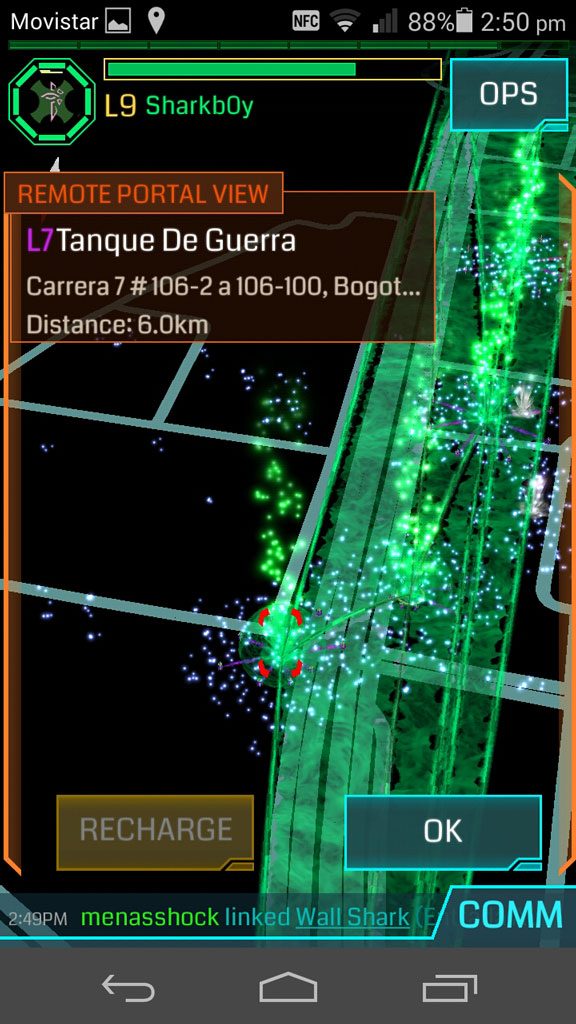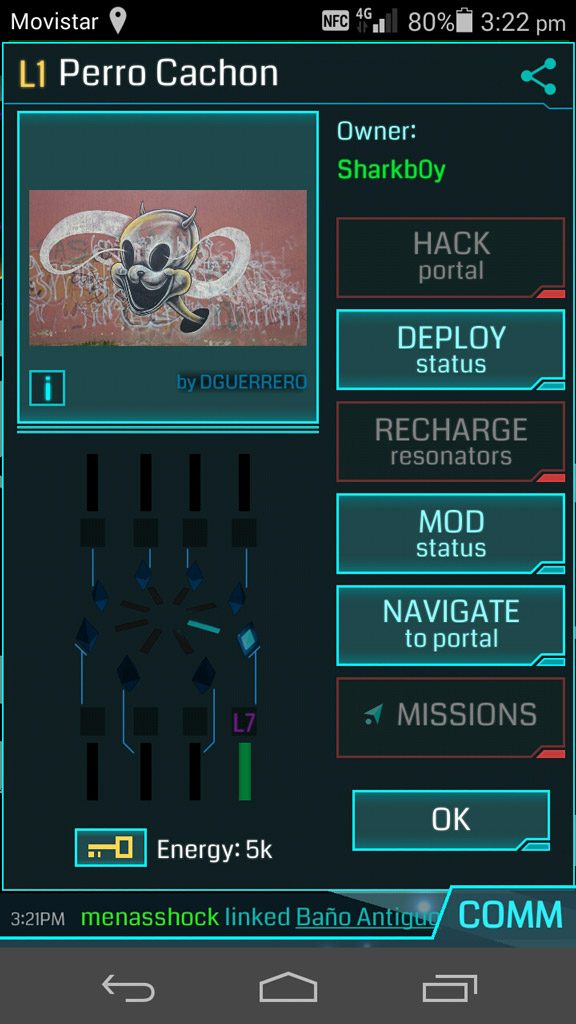Believe it or not, there’s a mobile phone battle going on around you every day for virtual control of the sights of Colombia – and indeed the world through augmented reality. Phil Stoneman takes a look at a unique way to see the city and be part of this growing community
So, I’m walking up a shady Bogotá side street, mobile phone in hand, and conscious that I probably shouldn’t be here, much less with my precious mobile on display. Regardless, I carry on, ignoring the people peeking out of their windows to see this curious foreigner wandering up their street, which is well off the beaten track for most non-residents. I see a massive graffiti mural on a corner further up the road. I check my phone and see a blue flare just within reach – that’s the enemy portal I was looking for, and it’s now mine for the taking. I make a couple of quick taps, and see the portal pleasingly change from blue to green – now it’s mine! Job done, I slip my phone into my pocket and stride off, back to a main road and back to a welcomingly better lit part of the city.
What is Ingress?
Ingress is basically a worldwide continuous scavenger hunt that works through the GPS on your smartphone. Join either the ‘enlightened’ green team or the ‘resistance’ blue team and capture ‘portals’ around the city.
Phil Stoneman is one of hundreds of players in Bogotá and a member of the green team who currently control about 55% of the city (though this changes all the time).
Welcome to the world of Ingress. Originally launched in November 2012 by Google offshoot Niantic Labs, Ingress turns your smartphone into a GPS-enabled scanner which shows you how to see not only the streets around you, but also strategically-placed portals, which is where the “augmented” part of this augmented reality game comes in. These portals are key to the game, as the two rival factions in Ingress battle it out to take over these key points and so control parts of the city.
These portals aren’t just anywhere; they’re generally historical sites or points of interest, suggested by the app’s users. This means that the portals can take many forms, including graffiti, landmarks or notable buildings – within La Candelaria for example, after capturing portals around Bolivar square, you can then capture dozens of sites as you make your way along the séptima to the gold museum. Some of these are obvious landmarks that you can hardly miss, while others are in more tucked away places that you may not otherwise visit. All of them give you a different insight into both the history and contemporary makeup of Bogotá’s colonial hub, as the site of Gaitán’s assassination rubs shoulders with a Toxicómano mural. La Candelaria, in common with many parts of the city, boasts portals as far as the eye can see.
And just how far you can see is an important element in the game. Whilst most smartphone maps are flexible enough to let you drag them around and see anywhere you want to, Ingress’s scanner will stubbornly only let you see what’s directly around you, and only interact with portals that are within a 40-metre radius of where you are. Which means that if you want to play the game, you’re going to have to get up and out of the house, and either walk or cycle your way around the portals. Driving isn’t much of an option, as the game automatically shuts off your actions when it detects that you’re travelling at higher speeds, therefore encouraging you to leave the car at home.
This makes the game an intriguing mix between gaming geekery and exercise, as getting out and pounding the pavement is an integral part of the gameplay. One strange side-effect of this is that, since starting the game, it’s become basically impossible for me to walk anywhere in a straight line. A previously straight-forward walk to the local shop has now become an epic, sprawling zigzag as I notice one portal, then another, and another, that I might as well visit while I’m out and about. In parts of the city that are less well-endowed with notable landmarks, many portals take the form of colourful and evocative graffiti. This is quite a bittersweet element of the game, as at times you arrive to where the app is showing you a quite remarkable piece of graffiti, only to find that the wall in question has now been painted over and the artwork lost forever.
What is augmented reality?
Augmented reality is not about wearing sci-fi glasses or entering some Matrix-esque future, it’s about adding input from your smartphone or computer to your day-to-day environment – in this case, adding the game to your walk to work or your weekend activities.
You’re not alone out there either, as community is an integral part of Ingress and, with a million active players worldwide, cooperative play is essential. It’s common for players to arrange meet-ups where they can exchange items, combine their forces and generally just catch up with each other. To the outsider, these are quite strange gatherings, as a group of players stand on the street in a rough circle, staring at their smartphones and tapping away whilst chatting away to each other, but this social aspect is key for many players. As Julian, who’s been playing Ingress in Bogotá since it first launched, told me, “the best thing is getting to meet people with different jobs, and learning about their different interests and hobbies. We even meet up with people from the opposing faction, and have a coffee and we’re friendly enough, though we know that right afterwards, we’ll be back to destroying their portals! But especially for people who are usually a bit shy about meeting new people, it really helps to break the ice.”
All the same, ice may well be the last thing you think about being broken, given that the game simultaneously combines staring at your smartphone screen and walking around a city that’s not exactly known for its level surfaces and covered drains. It doesn’t take much imagination to see how easily personal injury and cellphone damage could come about with a game that encourages even more ambulatory mobile use than Facebook or Whatsapp. Added to that, considering that 371,445 mobile phones were reported as stolen in Bogotá last year, there’s often an understandable reluctance to flash your expensive device on the streets if that might make you a target for crime.
However, with a bit of caution and common sense, you can play the game without joining the crime statistics. Indeed, many studies show that by getting out more and reclaiming the streets, we can all be part of reducing the risks.
As the cost of smartphones decreases, and investment in digital infrastructure continues, analysts predict that by 2018, smartphones will represent over 60% of mobile phone ownership in Colombia. As such usage becomes more commonplace in Bogotá, there’s a good chance of seeing many more games along the lines of Ingress. Augmented reality, while having existed at least theoretically for many years, is only now becoming a practical possibility and it’s still unclear what impact this technology will have as new app-based tools and games appear.
We are fast approaching a new era of augmented reality, not just in terms of mobile gaming, but in terms of the lens that technology offers us to see the streets we live in. Who knows where it will lead, but for sure Ingress is a fascinating insight into what might be.






